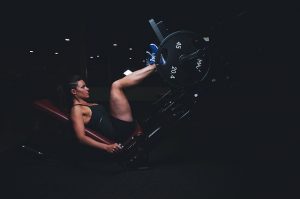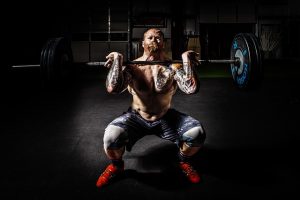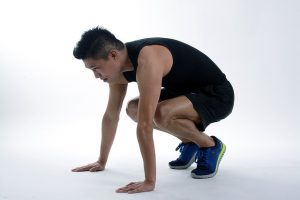Training the quads is probably the most challenging thing you’ll ever do in the gym. It takes more effort, is more painful and demands more mental intensity than working any other body part. Unless you are following a targeted, quad-specific program, however, you can end up wasting a lot of your effort.
In this article, we’ll present you with a variety of quad training programs that zero in on the quads, rather than the glutes or hamstrings, in order to create ideal quad development. And we’ll do it without performing a single back squat.
Best Quad Exercises with Weights
#1- The Roman Chair Squat- Best Exercise for the ‘Teardrop’
Take a look at a picture of a top bodybuilder’s quads and you will immediately see what the teardrop is. It is the area above the knee that is officially called the vastus medialis. The single best exercise to develop this area is the Roman Chair Squat. Don’t worry if you’ve never heard of it – not many guys have, which is probably why there aren’t that many walking around with fully developed ‘teardrops’.
The Roman Chair Squat was developed by Vince Gironda, the original Iron Guru. Vince was renowned for not allowing anyone in his gym to do back squats, believing, quite correctly, that they would enlarge the glutes and throw off the guy’s symmetry. He advocated front squats and hack squats, along with this roman chair version.
How to Do the Roman Chair Squat
Vince Gironda had a special piece of equipment built to perform the Roman Chair squat that was comprised of a foot brace to lock in the feet and a bar behind the knee that you squat over. However, you don’t need to have one of these units to benefit from this great exercise. Instead you can use a Smith Machine.
Get hold of a step-up platform or something similar that you can place your feet on when doing the exercise. Place an exercise band around this platform so that you can brace your feet between the band and the platform.
Now, set the bar on the Smith Machine to a level in line with your knees when you are standing on the platform. You are now ready to get started.
Position yourself so you are facing away from the Smith Machine with your feet braced and the backs of your knees resting against the Smith Machine bar. Begin by warming up with quarter and half squats with your hands folded across your chest. Do about twenty reps in order to warm up the joints, tendons and muscles. As you move through your warm up reps, go deeper and deeper.
When you are ready to begin your first actual working rep, lean back into a reclining position in order to maximally load the quads. Then lower down into a full squat. You will feel a fantastic stretch on the upper quads as you go down and you’ll be amazed at how hard the quads have to work to get you back up again.
You can begin to add weight as you get used to this exercise by holding a plate across your chest. However, you will not need to go that heavy in order to get the full benefit from this exercise.
#2- Front Squats- Best for Targeting the Quads
A great alternative to the back squat, which loads the glutes, is the front squat. Yet a lot of people find it uncomfortable and tricky to work with a free weight bar sitting across the front delts and chest. The solution is to do the front squat on a Smith Machine. You’ll find it a lot more comfortable to perform, especially if you are facing away from the machine as you perform the exercise.
How to Do a Front Squat
To perform the front squat on a Smith Machine, first place a couple of 5-pound plates on the ground slightly in front of the Smith Machine bar. You will place your heels on these plates in order to get you in the ideal biomechanical positioning for the exercise. Having the plates slightly forward will also allow you to get the lean back positioning that you want when squatting in order to take the glutes out of the movement. You cannot achieve this when doing the front squat with a free barbell.
When performing the front squat be sure to go all the way down to a full squat position. However, do not come out to lock out. You want to maintain tension on the quads throughout the entire set, so only come up three quarters of the way.
#3- The Goblet Squat- Best for Glutes and Quads Together
The Goblet Squat is a resistance-based version of the squat that has you holding either a single dumbbell or kettlebell against your chest as you descend into and out of a full squat.
How to Do a Goblet Squat
Start the exercise by grabbing hold of either a kettlebell or a dumbbell. With a kettlebell, hold the horns and press the bell against your chest. If you choose to use a dumbbell, position the weight on the top edge of a bench and cradle the base of the top portion between your hands. Now lift it off and press it against your chest.
Position your feet slightly wider than shoulder width and pointed slightly outwards. Push your feet out as if you were ‘spreading the floor’. Of course, your foot position will not actually change, but you will be pushing to the outer edge of your shoes. This will help to keep your knees tracking properly. Throughout the movement keep your torso as upright as possible.
Your feet should be flat on the ground. Now, sit back by leading with the hips as if you were sitting in a chair. Actively descend into the bottom of the squat by pulling yourself down with your hip flexors as you drop your center of mass until the tops of your thighs are slightly lower than parallel with the floor.
At this point, your elbows will be down at the level of your knees. Allow the elbows to push the knees out slightly. Now, push your heels firmly into the floor to drive yourself out of the squat. Extend yourself directly upward to straighten your legs.
Kettlebell or Dumbbell?
Whether you use a kettlebell or a dumbbell for the goblet squat is often a matter of availability. When you start to go heavy, it can be difficult to find a kettlebell that fits the bill. When you do have the choice, it’s interesting to note that many people find gripping the dumbbell less comfortable.
However, it is easier to keep a dumbbell close to your chest when you’re going up and down. This keeps the resistance closer to your midline, which prevents forward alignment. In the end, though, it’s a matter of personal preference.
What Makes the Goblet Squat So Good
Many people find the goblet squat a far more natural movement to perform than the traditional back squat. Having the weight in front of you, rather than on your back, provides three key advantages:
1. It takes the pressure of the load away from your spine
2. Having the weight in a goblet position at chest level provides an effective counter balance, enabling you to sit further back into the lower squat position
3. It removes the psychological fear of being buried under the weight
The goblet squat is closer to the natural unweighted squatting movement, which is intrinsic to humans, than the back squat. Before the invention of the seated toilet, squatting to relieve ourselves was something that we did several times each day. We did it with our hands in front of our body and our body descending down so that we were squatting between the legs. This is the exact goblet squat movement.
Another benefit with this exercise is that it is a more simple movement than the back squat. Because of this you don’t have to overthink the goblet squat. It is this overthinking that causes many people to go astray with the back squat.
The goblet squat allows you to descend into a deeper squat than the back squat. It also keeps your knees more properly aligned, preventing them from caving in as you descend. You are able to use your elbows to force your knees apart.
The hand positioning of the goblet squat also puts you in a much better position to ensure proper low back positioning. The start position of the movement, with your arms in front of you, gives you excellent counter balance and bracing against rounding your back. You do not get this with the back squat. The positioning also allows you to use the muscles of your upper back to counter collapse in the lower back that can occur on the back squat when the weight starts to get heavy.
Goblet Squat vs Front Squat
The front squat involves loading a barbell weight across the front of the shoulders. You need to maintain a more upright position than when doing the back squat, but this move allows you to better target the quadriceps and the muscles of your core. This move allows you to go deeper than the back squat.
In order to maintain a secure bar position across the front of your upper body, there are a couple of gripping options with the front squat. The cross arm grip is the most popular, but the Olympic grip can also be used, where you place your hands on the bar at shoulder width with your elbows in at your sides. You should squeeze the shoulder blades together for better stability.
The front squat is more closely aligned with the goblet squat as they both provide anterior loading. This places the load closer to the center of mass. However, many people find the positioning of the bar across the chest to be very uncomfortable. The greater spread of the mass of a front loaded barbell as opposed to the concentrated mass used for the goblet squat also makes the exercise more prone to forward tilt and spill.
On the plus side, the front barbell squat allows you to more closely approximate the weight that you can get up to on the back squat. The result is that you can get stronger and build more quad mass with the front squat than you can with the goblet squat.
Why No Back Squats?
What’s the one exercise that is universally recommended, and yet just as universally incorrectly performed?
The back squat.
This powerful lower body strengthener and quad mass builder is often performed in such a way as to place undue stress on the knees or lower back. Then, there are those who have a deep-seated fear of the exercise, convincing themselves that it will leave them buried beneath a pile of iron.
There is no doubt that the back squat is a great lower body developer. It is not, however, the best mass building exercise that you can do for your quadriceps. When you have the weight over your back, you are inevitably going to recruit too much gluteus maximus involvement for your quads to get that much stimulation. As we are attempting to keep our spine in a neutral position, we have a tendency to shift all of our weight back so that the load is all in the glutes. It’s only through about a third of the pushing out of the hole that we actually get direct quad stimulation during a back squat.
The result of the glute dominance in the back squat is that the hips tend to widen which results in a blocky look to the physique. In order to get full activation of the quads on any type of squat movement, you need to be in a leaning back position, as this will deactivate the glutes. You cannot do this when the bar is on your back.
Goblet Squat Shortcomings
While it is a much safer exercise than every other version of the weighted squat, the goblet squat does have a few drawbacks:
- It’s difficult to go really heavy on this exercise. Handling anything over a 100-pound dumbbell or kettlebell will be a real challenge in terms of getting into position and holding the weight in position.
- It is a difficult exercise to spot on
- It can be difficult to find kettlebells or dumbbells heavier enough if you are wanting to do reps in the 5-8 range
- Heavy goblet squats can pull the center of gravity of the body forward, compromising your lower back positioning
Goblet Squat Form Recap
- Feet slightly wider than shoulder width
- Feet flat on the floor
- Spread the floor apart
- Push to the outside of the feet
- Tighten the core
- Look directly ahead
- Squat between your legs
- Push your knees apart with your elbows
- Keep the torso upright
- Push down into the floor with your heels
One and a Half Reps for All Moves
A great intensity enhancer for the quads is to perform one and a half rep sets. This involves going down into a full descent and then only coming back up half way before going down into the full descent again. It is a great way to put maximum tension on the quads. At the end of the set your legs will be on fire. We only recommend doing one and a half reps on the first set of the exercise, when your legs are the freshest!
Weighted Quad Workout Programs
Now that we’ve provided you with a good grounding in the best exercises to build your quads, let’s put them into program form. Here are two workouts that can be used consecutively. Add weight with each succeeding set on squat movements, with the goal of adding 5 pounds to your starting weight every week. Perform one for a month, then switch to the other for the next month, going back and forth in that fashion. We’ve added in hamstring and calf exercises to make a complete leg program.
Program A
- Front Squats – 10 reps (one and a half reps), 8 reps, 6 reps, 6 reps
- Roman Chair Squats – 12 reps, 12 reps, 12 reps
- Leg Extensions – 12 reps, 12 reps, 12 reps
- Straight Legged Deadlifts – 10 reps, 8 reps, 6 reps
- Standing Calf Raises – 15 reps, 15 reps, 15 reps
Program B
- Goblet Squats – 10 reps (one and a half reps), 8 reps, 6 reps, 6 reps
- Hack Squats – 10 reps (one and a half reps), 8 reps, 6 reps, 6 reps
- Lunges – 12 reps, 12 reps, 12 reps
- Leg Curls – 10 reps, 8 reps, 6 reps
- Seated Calf Raise – 15 reps, 15 reps, 15 reps
Best Bodyweight Quad Exercises
Think quad training and most people’s minds will gravitate toward the squat rack. There is, however, a different, and many would say, better way. Your body provides all the training ‘equipment’ you need to sculpt legs to impress.
Here are the 6 best bodyweight quad exercises.
#1- Sissy Squat
The sissy squat is so called, not because it is for sissies, but because it will make a sissy out of the most hardened of muscle bound behemoths. It’s not an easy exercise to perform, involving three distinct phases as follows:
Phase One: Knee Drop
Stand on a 2 x 4 board
Bend the knees and drop down while also leaning the torso back
Drop down as low as possible
Do 5 reps then go to the next phase
Phase Two: Burlesque Bump
Squat down and thrust the hips up quickly
Return to the low squat position
Do 5 reps then go to the next phase
Phase Three: Flushing
Combine both phases one and two together
Drop into the knee drop then into the low squat position the thrust forward
Stand up in a continuous pattern
Do 5 reps
#2- Wall Sit
Stand with you back against the wall and your feet about twelve inches from it. Lower down as if you were sitting in a chair. In the bottom position your legs should be parallel to the floor.
Place your arms against the wall and keep them there throughout.
Drive your heels into the ground as you tense your thighs. Stay in this position for the set period of time. Keep your shoulders pinned against the wall throughout.
#3- Wide Stance Squats
Spread your legs fairly wide with the toes pointing forward.
Sit back and down into the lowest position possible. Keep the knees from going over the toes.
Keeping the head in line, squeeze the hips forward to power back up to a standing position. Breathe out on the way up.
#4- Deep Ape Squat
Crouch down into a full squat and put your palms on the ground in front of you.
Rise onto your toes, turning your thighs outward. Open up your arms as you spread them out to the sides. Hold for a count of 3 and return to the start position.
#5- Bulgarian Split Squat
Position a platform, stool or table that is about 16 inches high directly behind you. Place one foot on the platform with the other leg directly in front of you.
Squat down directly, keeping a tight core. Bring the rear knee down as far as you can. Push through your front thigh to rise back.
#6- Deep Squat
Stand with your feet shoulder width apart and your arms out directly in front of you.
Sit down and back into a deep squat position. Keep the butt engaged and the quads up slightly, so that you hold the tension in the squat.
Hold the bottom position for 10-20 seconds.
Putting it All Together:
Bodyweight Quad Workout A
Perform this workout three days per week on alternate days. When it comes to wide stance squats and the wall sit perform these two moves as a superset, going directly to the wall sit after each set of wide stance squats.
- Sissy Squats – 4 sets of 15 reps
- Wide Stance Squats – 3 sets of 20 reps
- Wall Sit – 3 sets of 60 Seconds
Bodyweight Quad Workout B
When it comes to deep ape squats and the wall sit perform these two moves as a superset, going directly to the wall sit after each set of deep ape squats.
- Bulgarian Split Squat – 4 sets of 15 reps (each leg)
- Deep Ape Squat – 3 sets of 20
- Wall Sit – 3 sets of 60 seconds
- Deep Squat – 2 sets of 20 reps




I’ve been going to the gym for a few years now and I’ve struggled at getting that tear drop. I’ve never heard of the roman chair squat before and I hope adding it to my routine will help develop that tear drop! Probably should be doing legs more than 1 time per week but man I hate leg day. Thanks for the suggestions!
Landmine squat = goblet squat with heavy weight! Add the Viking attachment and it rests on shoulders